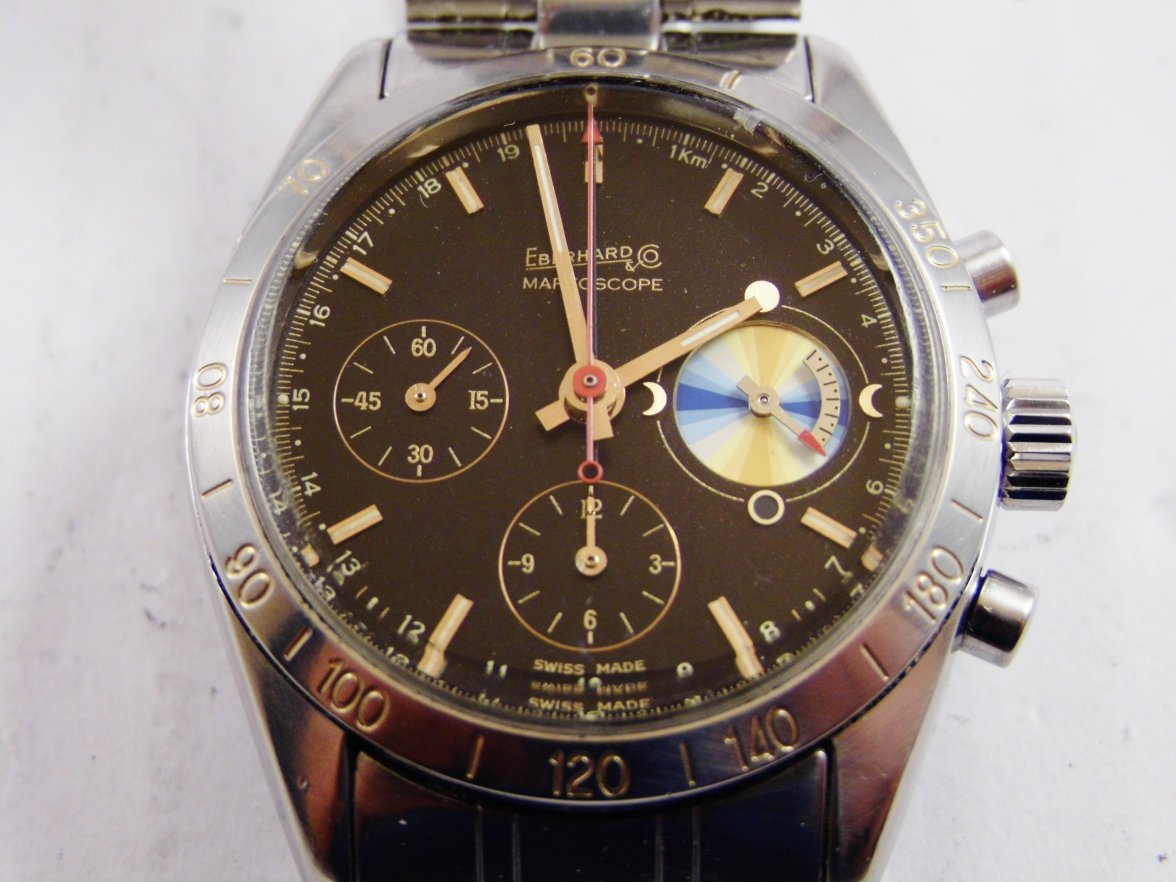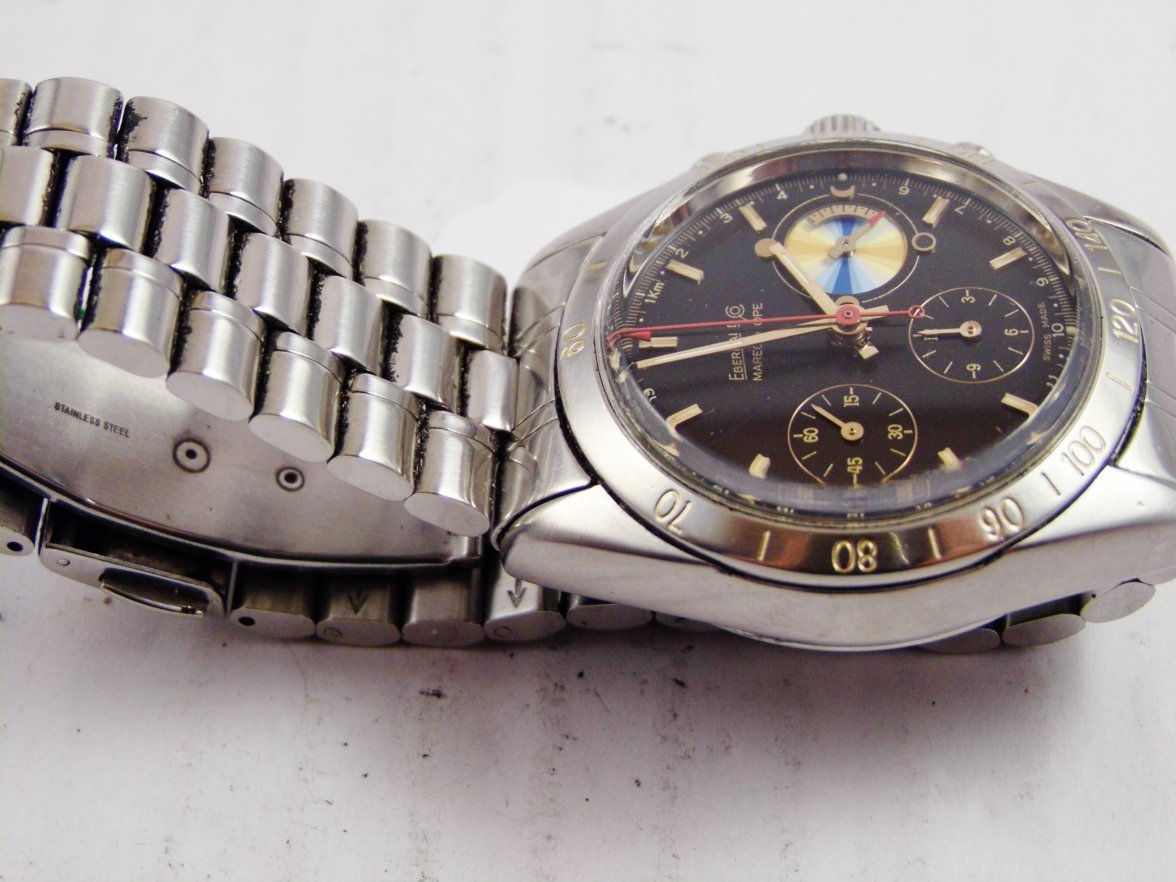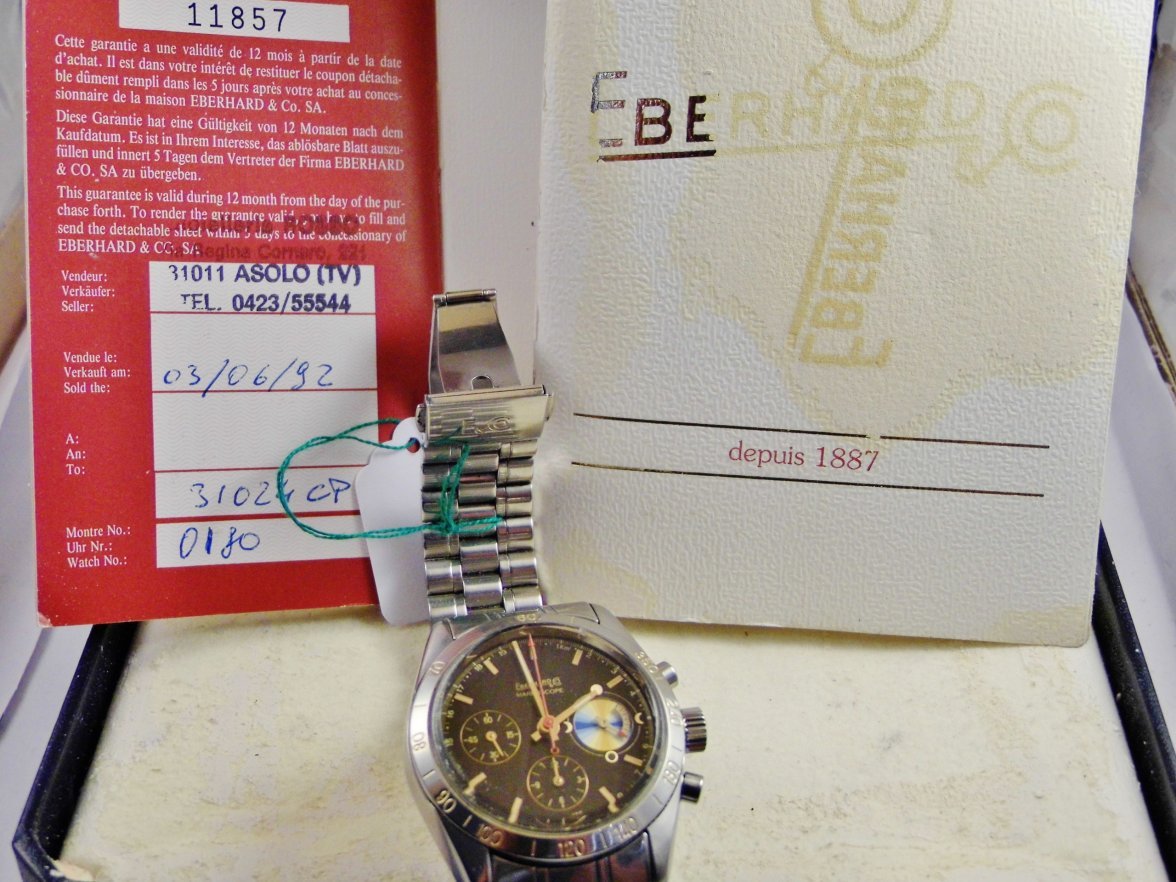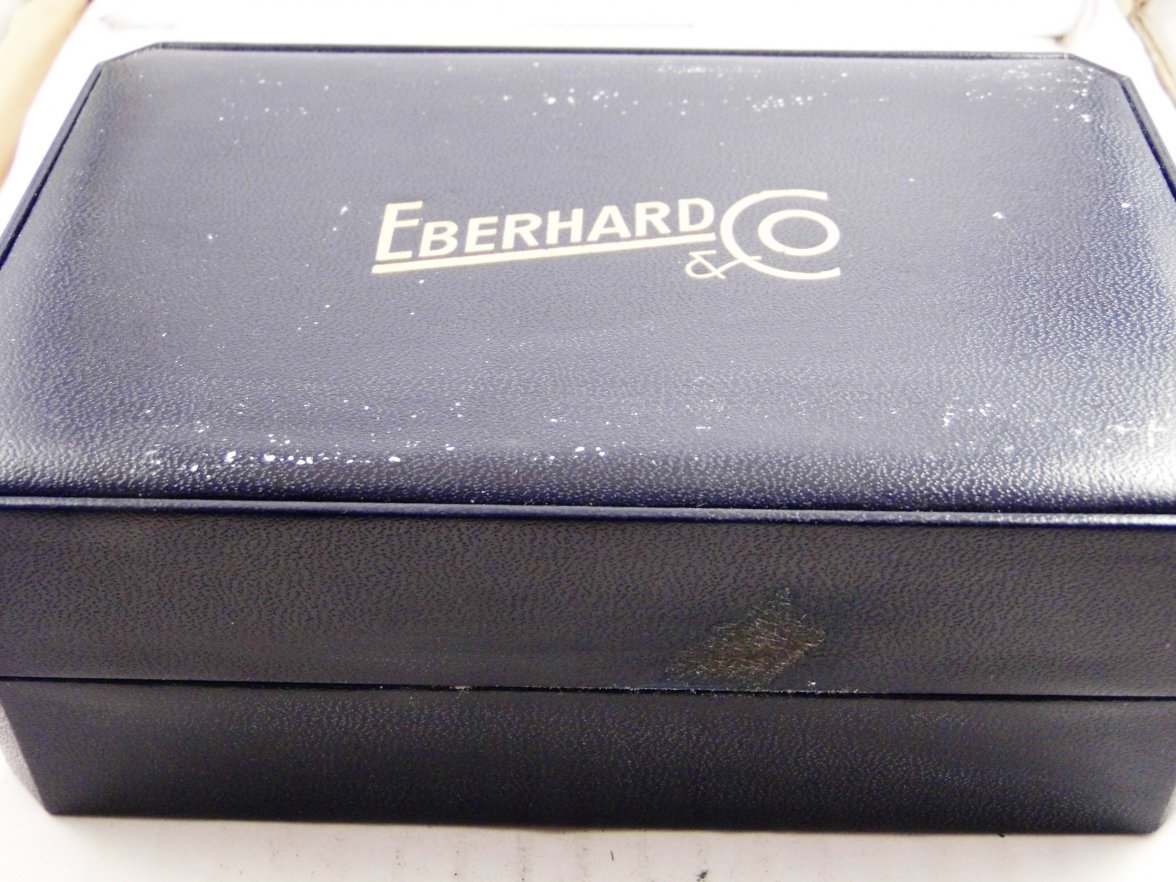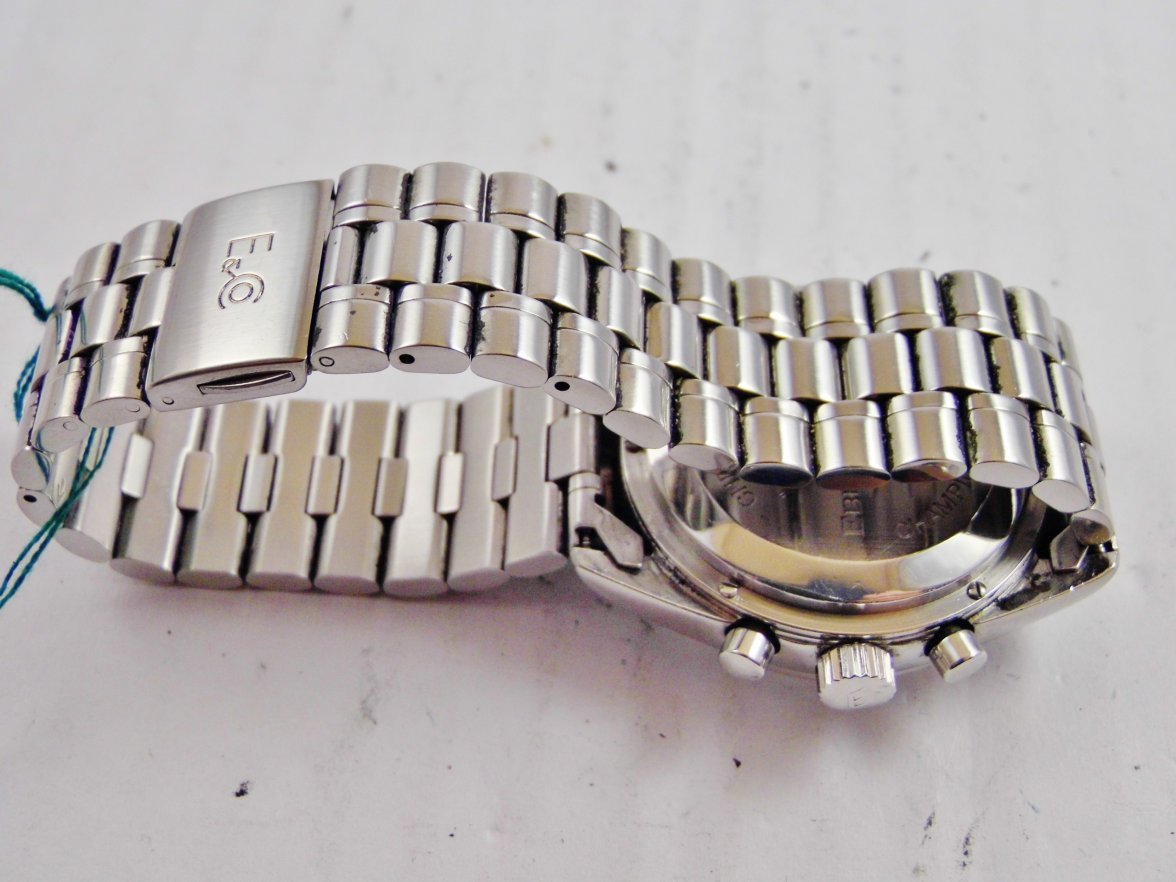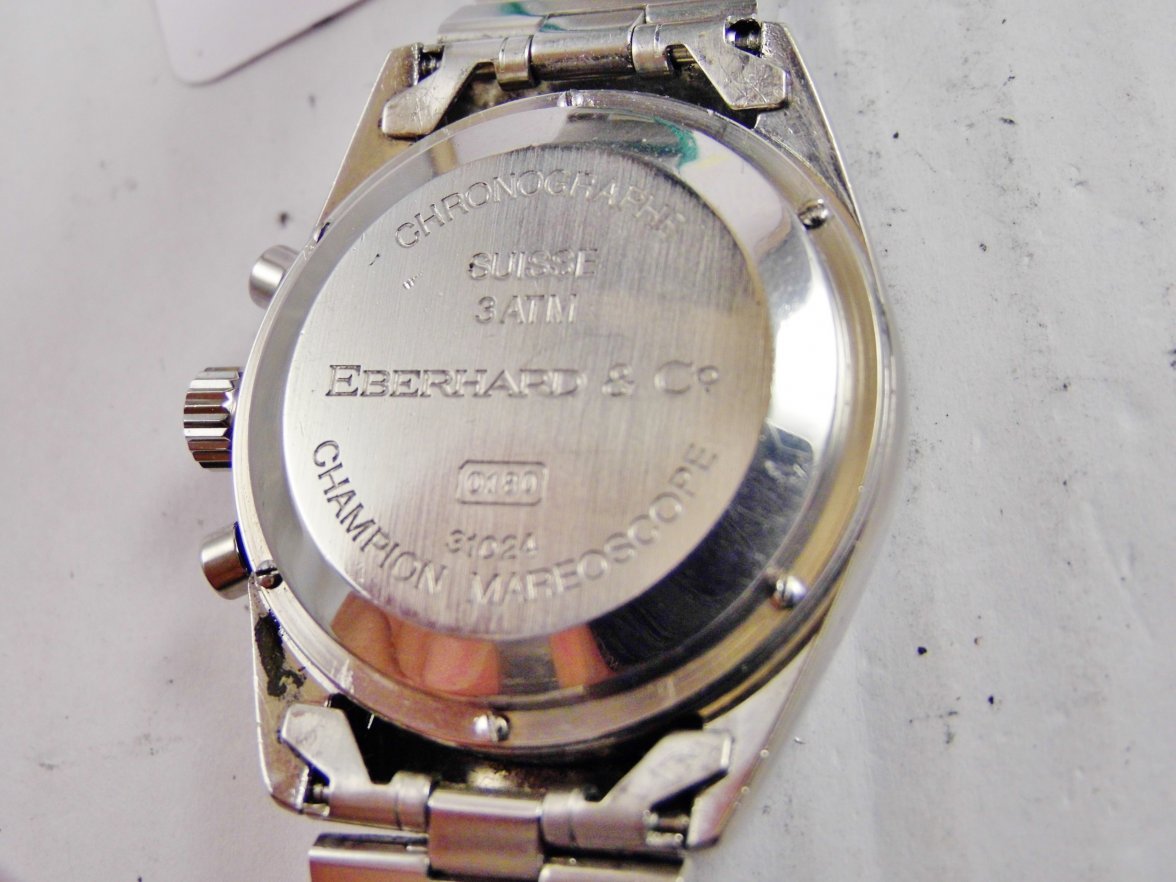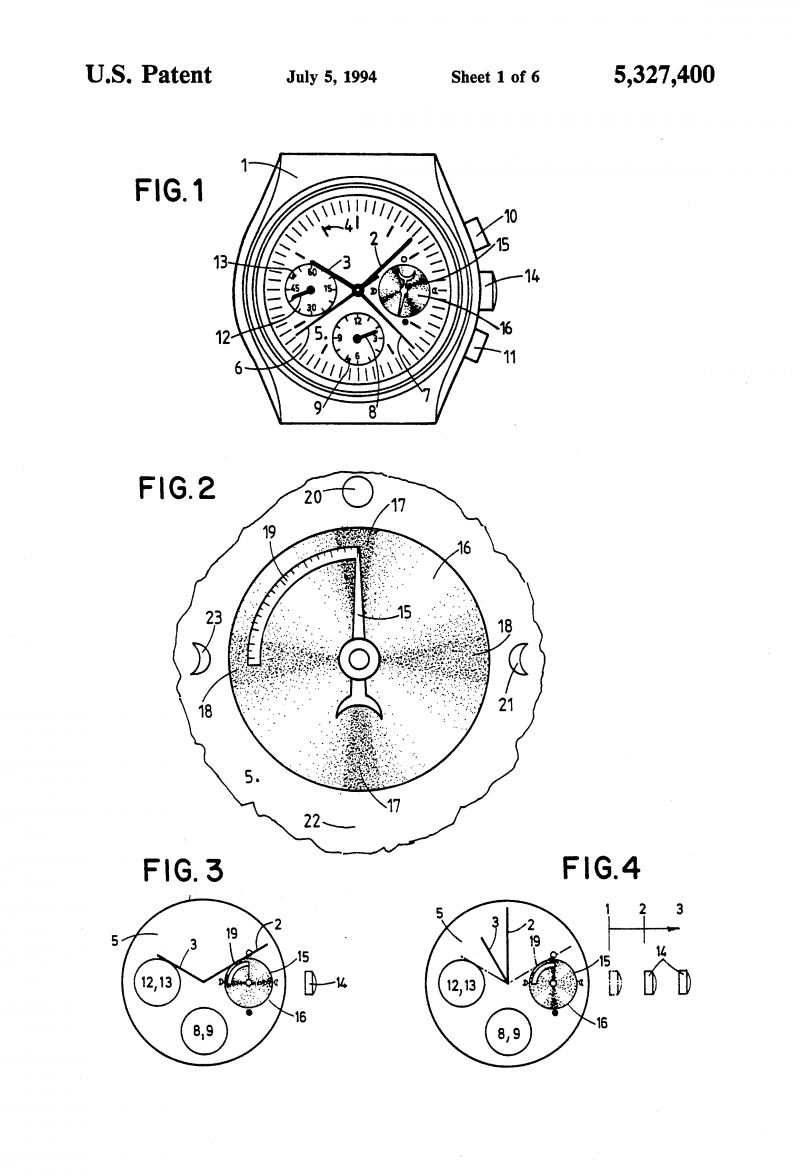Northernman
··LemaniacSo, I am a sucker for Lemania. 😎
The 5100 is not their prettiest of their calibers, but must be one of their most versatile.
There are several versions based on the 5100 caliber. The base caliber and the "slow beat" 5012 is by far the most common.
Some time ago, reading up on the late chronograph guru Chuck Maddox writings, I became aware of the perhaps most complicated version, the 5190.
In short the 5190 is a 5100 that has swapped the day/date/24h function for a moonphase and tidal display😲.
Being a "man of the seas", even making my living indirectly from seafaring activities, I was charmed to say the least.
Now, finding one is not that easy. At least if you do not want a tired and over prized sample.
The 5190 was ONLY used by Eberhard in one single model, the Mareoscope. Eberhard was, at the time, under the same ownership as Nouvelle Lemania (and Breguet - more to follow on a write up in planning). And the production volumes must have been low.
After some bargaining with a very sympathetic Italian dealer, this one is booked for transport to good ol´Norway.
😁 (Sellers pictures).
Box, papers and the original bracelet (in dire need of cleaning).
(Read below for more info).
The US patent is linked here: https://www.google.com/patents/US5327400
And for those not bothered by clicking the link for all the details:
"The present invention has for its object a watch movement more particularly a wrist watch, a chronograph watch or a pocket watch which comprises a time display formed by a dial and hands and which comprises a tide indicator constituted by a tides disk 16 which is to be seen through a window of the dial 5 and which makes one turn in twenty-four hours. This disk is driven in rotation through the hand display. A moon phases hand 15 is also driven by the hand display, at the speed of one turn in 29.5 days and cooperates simultaneously with the tides disk 16 and with the signs 20 to 23 representing the phases of the moon disposed on the dial 5 around the tides disk 16."
The aim of the present invention is to remedy to the drawbacks of the time pieces existing and which permits particularly for yachtmen and sailors to integrate in a wrist watch or in a pocket watch an indicator showing simultaneously the movement of the tides and the moon phases.
The display of the tide indicator is shown in detail at FIG. 2, it comprises a tide disk 16 which can be seen through a circular window provided in the dial 5. This tide disk 16 comprises different colored zones 17,18 indicating respectively the high and low tides. The portions of this disk 16 located between the zones 17,18 can have shades of colours. This display comprises further the moon phases hand 15 pivoted concentrically to the tide disk 16. This moon phases hand 15 comprises at its end a graduated sector 19, extending on about a quarter of a circle. This sector extends thus over an angular distance or arc of circle corresponding to a fourth of the tide disk 16, that is to say over a distance corresponding to six hours that is the time interval separating a low tide from a high tide. As said before, the tide disk 16 makes one revolution in twenty-four hours and turns in the direction of the watch hands whereas the moon phases hand 15 and its sector 19 representing half a tide cycle (6 h 12 min) will make in the same direction one revolution during a moon cycle, i.e. within 29.5 days. This moon cycle hand indicates the phase of the moon by cooperating with the signs 20,21,22,23 representing the moon phases which are applied to the dial 5 around the disk 15. Simultaneously, this hand 15 indicates the position of the tide in differential values of the position of the zones 17,18 of the tide disk 16 with respect to the arrow of the hand 15.
When the hand 15 is located at the center of the zone 17, the high tide is at its culminent point and it will enter in its decreasing phase. It expresses itself by two tides or periods within twenty-four hours and forty eight minutes and forty-eight seconds.
The sector 19 enables to represent graphically the approximate time of half a tides cycle or period. In using this sector, we can note that:
in three hours six minutes one will be in a neutral zone.
in six hours twelve minutes one will be at the culminent point of the low tide.
In looking at FIG. 2, we can see that:
the arrow of the hand 15 of the moon phases indicates that one is in a period of full moon since it is in front of the sign 20.
the arrow of the hand 15 of the moon phases which is superimposed to the center of the zone 17 indicates that one is at the culminent point of a high tide.
the sector 19, which is fast with the arrow of the hand of the moon phases 15, superimposed with the tide disk 16 enables to read approximately the time resting until the next low tide.
The 5100 is not their prettiest of their calibers, but must be one of their most versatile.
There are several versions based on the 5100 caliber. The base caliber and the "slow beat" 5012 is by far the most common.
Some time ago, reading up on the late chronograph guru Chuck Maddox writings, I became aware of the perhaps most complicated version, the 5190.
In short the 5190 is a 5100 that has swapped the day/date/24h function for a moonphase and tidal display😲.
Being a "man of the seas", even making my living indirectly from seafaring activities, I was charmed to say the least.
Now, finding one is not that easy. At least if you do not want a tired and over prized sample.
The 5190 was ONLY used by Eberhard in one single model, the Mareoscope. Eberhard was, at the time, under the same ownership as Nouvelle Lemania (and Breguet - more to follow on a write up in planning). And the production volumes must have been low.
After some bargaining with a very sympathetic Italian dealer, this one is booked for transport to good ol´Norway.
😁 (Sellers pictures).
Box, papers and the original bracelet (in dire need of cleaning).
(Read below for more info).
The US patent is linked here: https://www.google.com/patents/US5327400
And for those not bothered by clicking the link for all the details:
"The present invention has for its object a watch movement more particularly a wrist watch, a chronograph watch or a pocket watch which comprises a time display formed by a dial and hands and which comprises a tide indicator constituted by a tides disk 16 which is to be seen through a window of the dial 5 and which makes one turn in twenty-four hours. This disk is driven in rotation through the hand display. A moon phases hand 15 is also driven by the hand display, at the speed of one turn in 29.5 days and cooperates simultaneously with the tides disk 16 and with the signs 20 to 23 representing the phases of the moon disposed on the dial 5 around the tides disk 16."
The aim of the present invention is to remedy to the drawbacks of the time pieces existing and which permits particularly for yachtmen and sailors to integrate in a wrist watch or in a pocket watch an indicator showing simultaneously the movement of the tides and the moon phases.
The display of the tide indicator is shown in detail at FIG. 2, it comprises a tide disk 16 which can be seen through a circular window provided in the dial 5. This tide disk 16 comprises different colored zones 17,18 indicating respectively the high and low tides. The portions of this disk 16 located between the zones 17,18 can have shades of colours. This display comprises further the moon phases hand 15 pivoted concentrically to the tide disk 16. This moon phases hand 15 comprises at its end a graduated sector 19, extending on about a quarter of a circle. This sector extends thus over an angular distance or arc of circle corresponding to a fourth of the tide disk 16, that is to say over a distance corresponding to six hours that is the time interval separating a low tide from a high tide. As said before, the tide disk 16 makes one revolution in twenty-four hours and turns in the direction of the watch hands whereas the moon phases hand 15 and its sector 19 representing half a tide cycle (6 h 12 min) will make in the same direction one revolution during a moon cycle, i.e. within 29.5 days. This moon cycle hand indicates the phase of the moon by cooperating with the signs 20,21,22,23 representing the moon phases which are applied to the dial 5 around the disk 15. Simultaneously, this hand 15 indicates the position of the tide in differential values of the position of the zones 17,18 of the tide disk 16 with respect to the arrow of the hand 15.
When the hand 15 is located at the center of the zone 17, the high tide is at its culminent point and it will enter in its decreasing phase. It expresses itself by two tides or periods within twenty-four hours and forty eight minutes and forty-eight seconds.
The sector 19 enables to represent graphically the approximate time of half a tides cycle or period. In using this sector, we can note that:
in three hours six minutes one will be in a neutral zone.
in six hours twelve minutes one will be at the culminent point of the low tide.
In looking at FIG. 2, we can see that:
the arrow of the hand 15 of the moon phases indicates that one is in a period of full moon since it is in front of the sign 20.
the arrow of the hand 15 of the moon phases which is superimposed to the center of the zone 17 indicates that one is at the culminent point of a high tide.
the sector 19, which is fast with the arrow of the hand of the moon phases 15, superimposed with the tide disk 16 enables to read approximately the time resting until the next low tide.
Edited:
